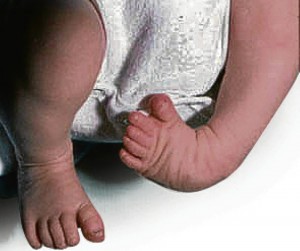
CLUBFEET that had undergone the Ponseti method remain strong, flexible, pain free and fully functional decades after the procedure.
The appearance is unmistakable: one (it could be both) foot is turned to the side or that it may even appear that the top is where the bottom should be. The calf and the rest of the involved leg may be smaller and shorter than the normal side.
Though it is not a painful condition, the presence of the clubfoot will lead to significant discomfort as well as cause debilitating physical and psychological burden to the child later in life, not to mention severe financial burden on the family.
Dr. Julyn Aguilar, organizing committee chair of the 19th Postgraduate Course Institute of Orthopedics and Sports Medicine, explained that doctors are still not certain why it happens, though it can occur in some families with previous clubfeet.
In fact, Aguilar explained that a baby’s chance of having a clubfoot is twice as likely if the parent, the spouse or other children also have it.
Change
“While it has been eradicated in the developed world, it’s a different story in the developing world as treatment for most children with clubfoot is simply not available. We want to change this as we don’t want Filipino children with untreated clubfoot face a lifetime of missed occupational, educational and social opportunities,” Aguilar said.
While the traditional mode of treatment was the employment of extensive corrective surgery on the affected foot or feet, Aguilar said there is another effective option that no longer needs surgery.
For years, the St. Luke’s Medical Center’s Orthopedics and Sports Medicine, has been offering the “Ponseti technique,” a particular method of stretching and casting that corrects congenital clubfoot without invasive surgery.
Dr. Ignacio Ponseti developed at the University of Iowa a method named after him that is nearly 100 percent effective when used properly by a trained healthcare provider.
“It may now be regarded as the “gold standard” treatment for clubfoot. But more importantly, doctors in underprivileged areas of the country with limited access to surgical facilities can be trained to use the method, helping hundreds and even thousands of Filipino children walk without impediment,” Aguilar said.
During the recent two-day postgraduate course (titled “The Ponseti Method for Treatment of Clubfoot”) held at at the St. Luke’s Medical Center in Quezon City, proper casting techniques were demonstrated by Doctors Jose Morcuende and William Whitmore, two experts who headed the international faculty from the the University of Iowa’s Ponseti International Association.
With the Ponseti method, the doctor changes the cast every week for several weeks with the aim of stretching slowly, the foot toward the correct position.
Once the foot has been corrected, the infant must wear a brace at night for two years to maintain the correction. This extremely effective method also requires the active participation of the parents for the braces application.
World’s most common
Clubfoot is the world’s most common congenital birth defect, affecting more than 200,000 newborn children a year.
It is said that 80 percent of these occurrences happen in developing countries that include the Philippines.
But the fact that famous individuals including former football superstar Troy Aikman, United States soccer legend Mia Hamm and former Olympic figure-skating champion Kristi Yamaguchi suffered from the condition only proves what an early intervention could do in the life of any young child.
“Most clubfeet can be corrected by Ponseti technique in two months or less with minimal or no surgery. The method is easy to learn, inexpensive and suited for both developed and developing countries like the Philippines. Long-term follow up studies showed that feet that had undergone the Ponseti method remain strong, flexible, pain free and fully functional decades after the procedure,” Aguilar said.

